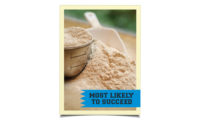Formulating successful dairy products can feel like a trapeze act even in the best of times. And 2020 was hardly the best of times.
As COVID-19 descended — bringing its now-infamous logistical upheavals with it — even veteran dairy brands found themselves working without a net. Yet despite flying blind at times, ingredient suppliers executed flawless handoffs with their dairy customers, securing essential inputs despite the risks.
Milk | Cheese | Cultured | Ice Cream | Butter | Non-dairy Beverages | Ingredients | Exports
And while getting through 2020 was hardly “the greatest of ease,” the fact that the dairy industry and its ingredient suppliers can now take a bow reflects the strength of their relationships and the resiliency of supply chains. With innovation continuing apace, we may fly even higher in 2021.
New tricks help dairy
No industry made it to 2020’s final quarter without suffering at least some COVID-related collateral damage. But the dairy sector has fared remarkably well, all things considered, as far as John Powers, director of marketing for Chicago-based ADM, is concerned. Retail dairy sales are “soaring,” he says, “thanks to consumer desire for wholesome, protein-packed nutrition; concerns about immunity; and a craving for comfort during stressful times.”
Yet dairy brands’ ability to feed those desires depends on ingredient suppliers’ ability to fill orders. And this year, that wasn’t always easy.
“Like many industries, we’ve had to deal with logistical challenges such as fewer containers and reduced shift work at harbors, and we needed a strong team effort to coordinate harvesting and mitigate delays to planned production works,” says Jon Peters, president of Beneo Inc., Parsippany, N.J. “But under the circumstances, we’re proud to say that we remained a reliable supplier of all the ingredients we produce.”
Peters believes the pandemic certainly impacted the way companies had to conduct business.
“But as we begin to accept the ‘new normal,’ we’re finding creative ways to maintain business almost as usual,” he says.
That creativity is on display in how companies conduct research and development under lockdown.
“While we did see an initial slowdown in new product development, activity has rebounded as our customers renew their focus on innovation,” Mark Fahlin, who works in business development for Minneapolis-based Cargill, notes.
Christine Addington, technical service representative for dairy and dairy alternatives at Cargill, adds that product development “initially took a backseat to consistent production” as brands tried to keep up with retail demand.
“Customers relied on their suppliers throughout those early weeks to help respond to the rapidly evolving marketplace with consistent ingredient supplies,” she says. “One of the biggest lessons we’ve learned as we’ve navigated these uncertain waters is how much ingredient suppliers and brands depend on each other for success. It may seem counterintuitive, but as we’ve worked in socially distant ways, we’ve collaborated on projects more closely than ever.”
High flying with key trends
Also counterintuitive: While conventional wisdom says that the pandemic’s changed everything, industry insiders contend that it’s actually strengthened, reinvigorated and magnified key trends already driving dairy development well before the novel coronavirus hit. Nowhere is that more evident than in the flourishing demand for health- and wellness-promoting products.
“The pandemic brought new focus onto health and overall wellbeing and how they’re linked to nutrition,” Peters says. “With more awareness about the importance of healthy eating, consumers now more than ever seek high-quality and convenient products with health-promoting properties.”
As evidence, he points to 2020 findings from FMCG Gurus showing that roughly three-quarters of consumers globally plan to eat and drink more healthfully in response to the pandemic.
Similarly, Powers notes that ADM’s proprietary OutsideVoice research found that 48% of consumers are planning to buy more items related to health and wellness in the next six months and beyond. That, Powers believes, spells “tremendous growth opportunity in the dairy space for product development with functional ingredients targeting gut health, weight management, cognitive health and immunity.”
A quadruple somersault for gut health
Greg Paul, marketing lead, beverages, dairy and frozen desserts, North America for St. Louis-based DuPont Nutrition & Biosciences, agrees.
“Consumers want added nutrition and health-enhancing products, and dairy’s a perfect vehicle for that,” he says. “Certainly, this is accentuated by the pandemic, but it was already taking shape before COVID-19.”
He’s betting that gut-health and immune-enhancing formulations will take off, noting that there are “quite a few new dairy products with added probiotics and even prebiotics such as fiber.”
In fact, Powers points to ADM research ranking fiber as the No. 1 ingredient that consumers are interested in adding to their diets, primarily for weight management, heart health and — yes — gut health. It’s already appearing in ice cream and other dairy desserts and deserves consideration in yogurt and dairy beverages, he says.
“ADM’s Fibersol line makes it easy to incorporate prebiotic fiber into applications without sacrificing dairy’s signature rich and creamy flavor and texture,” he says.
Peters notes that Beneo added organic options to its existing fiber line in the second half of 2020. To wit, OraftiOrganic is a first-to-market organic variant of the company’s chicory root fiber, a source of inulin and oligofructose. It offers dairy developers an organic prebiotic-fiber option that not only improves taste and texture, but also allows for fat and sugar reduction. Even better, he says, the ingredient exhibits good solubility across dairy applications.
While prebiotics are establishing themselves in healthy dairy — and probiotics have been there for years — postbiotics, bioactive products of microbial fermentation such as microbial cells, cell constituents and metabolites are just getting started.
ADM makes its HT-BPL1 postbiotic ingredient by heat-treating its probiotic BPL1. The resulting postbiotic ingredient brings metabolic-health benefits to a range of dairy applications, from yogurt to ice cream, and tolerates high-heat and other harsh processing conditions, including pasteurization, Powers says.
A full twisting double for plant-based
Another beneficiary of the pandemic’s spotlight on health and wellness is the plant-based trend, which is still going strong.
“There’s no denying the mainstreaming of plant-based foods and beverages,” Paul says. “And it’s not just beverages anymore. We’re seeing yogurts, frozen desserts, dips, spreads and even cheese — although that’s just starting to develop.”
Powers notes that plant protein, in particular, still enjoys traction with health-minded consumers. He suggests using blends of both plant and dairy proteins to raise protein levels in already protein-rich products such as milk and yogurt even higher.
“An expanding portfolio of plant proteins including pea, oat and almond is driving innovation in these blended protein products,” he says.
And in July, Danisco launched its Planit portfolio of ingredients to support the many steps involved in developing plant-based alternatives: fermentation, enrichment, stabilization, materials optimization. The ingredients help developers seize “an untapped opportunity to expand plant-based foods and beverages to more eating occasions, new formats and better experiences,” Paul says.
It’s no longer just about imitating dairy, he adds.
“People actually want the ‘plant’ taste, and they want it to taste good, too,” Paul explains.
Sugar tumbles off the trapeze
The catch: They’d also like it to contain less sugar.
“Consumers were plenty wary of sugar before COVID-19, but now, as a growing body of scientific evidence links factors such as obesity to a higher risk of more severe complications from the virus, those concerns have only magnified,” Fahlin notes.
Sweetener suppliers are on the ball, offering sugar alternatives and formulation expertise alike.
“Successful sugar reduction starts by identifying the best sweetener or combination of sweeteners for the application and factoring in consumer preferences, functionality, flavor and mouthfeel — all of which are crucial in the dairy space,” Powers says.
Fahlin notes that Cargill’s EverSweet stevia can cut calories steeply, replacing as much as 100% of a formulation’s sugar, while also maintaining sweetness, compensating for lost mouthfeel and keeping labels clean.
What’s more, Fahlin explains, by producing the ingredient via fermentation, Cargill creates a sweetener targeted to deliver optimal levels of rebaudiosides M and D — purportedly the best-tasting rebaudiosides in the stevia plant, but also the toughest ones to obtain when processing the plant itself.
The process is also cost-efficient and environmentally sensitive, he adds. What’s more, because the resulting stevia ingredient doesn’t carry the licorice aftertaste that plagues some of its counterparts, it delivers “a more rounded taste profile with a faster sweetness onset.”
Aaron Chip Venables, principal scientist for ice cream and fluid dairy at DuPont Nutrition & Biosciences, adds that enzymes can also help dairy developers reduce sugar levels effectively and cleanly. For example, the company’s Bonlacta is a trademarked form of lactase that speeds production of lactose-free dairy products and provides more heat resistance than standard enzyme systems. Meanwhile, Nurica — another trademarked lactase — “is instrumental in reducing lactose and sugar by converting the lactose into galacto-oligosaccharide, a non-digestible prebiotic fiber.” It’s almost like extra credit.
A triple twisting double for healthful indulgence
Venables also notes that his company’s Grindsted stabilizer systems open the door to higher-protein, lower-calorie and even keto-style frozen dairy desserts “that mirror the physical stabilization and eating characteristics of traditional ice creams.”
And that nod toward tradition is still important, for while COVID-19 has sharpened consumers’ focus on healthy eating — even at dessert — “consumers also want to keep enjoying their favorite foods and beverages,” said Philip Caputo, marketing and consumer insights manager for Virginia Dare, New York.
“During quarantine,” he continues, “the familiar experience of one’s favorite treats can be comforting and restore a sense of normalcy,” which bodes well for healthy takes on classic comfort foods or, alternatively, the inclusion of classic flavors in healthy applications as “a nice pick-me-up, or a permissible indulgence.”
Caputo is especially excited about the prospect for wellness flavors, which he said were already gaining ground prior to the pandemic, but are seeing even more growth now. And what is a wellness flavor?
“Certain ingredients evoke flavors associated with health and wellbeing,” Caputo explained, citing antioxidant-rich dark berries such as acai, elderberry and goji, as well as powerhouse foods such as ginger and mushrooms.
Sour flavors with a healthy halo — think pomegranate and kombucha — also please palates while signaling functionality, Caputo continues.
“And nutty profiles like avocado and chia combine well with healthy fats in nutritional beverage and shake mixes,” he says. “By integrating these wellness flavors into applications, dairy brands can underscore their focus on targeted nutrition categories such as immunity, brain health, aging and digestion.”
But when flavoring products for health or indulgence, Caputo counsels using natural options.
“Consumers associate natural flavors with health and wellness,” he reasons. “And while real, natural vanilla is the top flavor in ice cream, other natural flavors like chamomile, tea, chai, botanicals and tropical fruits can appeal to consumers’ sense of adventure and excitement.”
So there’s no excuse not to come up with a profile that gives consumers the best of everything: exploration as well as nostalgia, health plus a touch of hedonism and all the goodness of dairy. As Caputo says, “Dairy formulators have a broad palette available and should feel emboldened to experiment with innovative combinations and formats.”
Addington, for one, will be paying attention when they do.
“I’m looking forward to our customers refocusing on innovation,” she says. “While the pandemic’s effects may have long-lasting impacts on consumer behavior, those changes still spell opportunity for savvy dairy brands.”
Milk | Cheese | Cultured | Ice Cream | Butter | Non-dairy Beverages | Ingredients | Exports








